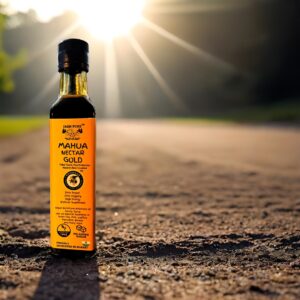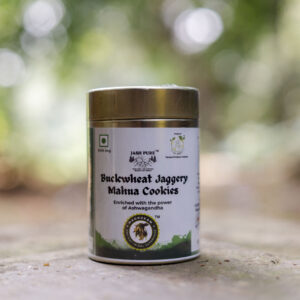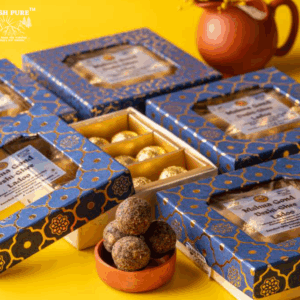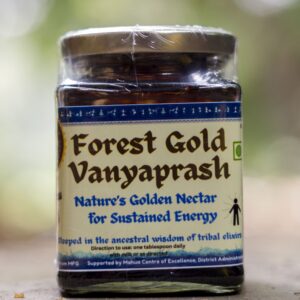The Flower that Ferments
Mahua (Madhuca longifolia) is unique among forest produce. Unlike most flowers, its natural sugars (40–70% of dry weight) make it ideal for fermentation. For centuries, tribal families across Central and Eastern India have relied on Mahua blossoms not just for food, but also for drink.
Mahua liquor is a paradox: sacred in rituals, vital in survival, yet stigmatized in mainstream society. In recent decades, researchers, entrepreneurs, and communities have begun to reimagine Mahua — from traditional brews to modern wines, functional beverages, and even bioethanol.
This blog explores the entire spectrum of Mahua beverages, from their role in village festivals to cutting-edge R&D in fermentation science.
Traditional Mahua Liquor – Ritual and Survival
Preparation Methods
- Blossoms are collected in early spring, sun-dried, then soaked in water.
- Natural yeast starts fermentation within 2–3 days.
- The fermented wash is distilled in earthen pots or metal stills, producing a clear, aromatic liquor.
Social and Cultural Role
- Ceremonial: Mahua liquor is served during weddings, harvest festivals, and ancestor rituals. In many Gond and Muria households, it is considered sacred when offered at shrines.
- Bonding: Sharing Mahua drink is a gesture of equality and hospitality — it erases hierarchy at community gatherings.
- Survival: For families facing seasonal hunger, Mahua liquor was sometimes a source of quick energy, especially for farmers working long hours.
The Stigma of Liquor
Colonial policies (19th century onwards) changed everything. Mahua liquor was heavily taxed, monopolized by excise laws, and labeled as “country liquor” — degrading its cultural and nutritional identity. What was once ritual drink and survival aid became stigmatized as a poor man’s addiction.
Fermentation Science – Mahua Under the Microscope
Mahua blossoms contain simple sugars (sucrose, glucose, fructose), making them highly fermentable. Modern research confirms:
- Yeast Fermentation: Saccharomyces cerevisiae ferments Mahua must efficiently, producing ethanol concentrations up to 10–12%.
- Wine Studies:
- Parmar (2020) found that adding 10% Mahua extract to grape must increased alcohol yield and changed tannin balance in red wine.
- Jha et al. (2013) developed improved brewing techniques that raised ethanol yields while reducing sourness.
- Bioethanol Potential: With optimized fermentation, Mahua can produce sustainable biofuel — bridging forest produce with renewable energy.
- Nutritional By-products: Even after fermentation, Mahua residues contain proteins and tannins that can be used as cattle feed or compost.
This shows Mahua is not only culturally significant but also a scientifically versatile substrate.
Beyond Liquor – New Frontiers in Beverages
1. Craft Wines and Vermouths
Small experimental wineries in India have begun producing Mahua blossom wines. These are marketed as craft heritage drinks with floral notes, positioned alongside honey wines or fruit wines. Vermouths blending Mahua with herbs have also been tested in pilot projects.
2. Non-Alcoholic Fermented Drinks
In tribal kitchens, lightly fermented Mahua gruels are common — energizing, hydrating, and safe for daily consumption. With refinement, these could become India’s kombucha-equivalent functional drink, tapping into global health beverage markets.
3. Ready-to-Drink Innovations
FPOs like Jai Jungle are experimenting with nectars, herbal teas, and mocktails made from Mahua. These products draw from tradition but are adapted for urban wellness markets, focusing on low glycemic index and natural energy.
Socio-Cultural Importance of Mahua Beverages
- Spiritual Symbol: Liquor made from Mahua is offered to ancestors, ensuring continuity between generations.
- Social Glue: In festivals, Mahua drink ensures everyone shares the same cup, reinforcing equality.
- Cultural Identity: For many tribes, rejecting Mahua liquor means rejecting part of their identity.
Yet, this importance coexists with risks of misuse, dependence, and social stigma — a double-edged legacy.
Challenges – Between Tradition and Regulation
- Health Risks: Informal brewing can produce methanol contamination or unsafe alcohol levels.
- Excise Restrictions: Most states strictly regulate Mahua liquor, often criminalizing tribal practices.
- Cultural Stigma: Mainstream India sees Mahua liquor as backward, ignoring its sacred context.
- Commercial Exploitation: Without fair trade, middlemen profit while tribal collectors remain underpaid.
These challenges highlight the need for policy reform and scientific innovation.
Jai Jungle and the Reimagination of Mahua Drinks
At Jashpur, Jai Jungle Farmers Producer Company is reshaping Mahua’s beverage identity. Instead of promoting liquor, the focus is on:
- Mahua Nectar – a natural sweetener and energy booster.
- Herbal Teas & Infusions – blends of Mahua with Tulsi, Lemongrass, Green Tea.
- Mocktail Prototypes – healthy, non-alcoholic drinks reimagined for modern consumers.
This approach restores dignity to Mahua by shifting the narrative from liquor to lifestyle, showing that Mahua beverages can be safe, nutritious, and empowering.
Conclusion – The Future of Mahua Beverages
Mahua beverages tell a story of paradox: revered and sacred in villages, but stigmatized in cities. Fermentation science has proven Mahua’s potential not only for liquor but also for craft wines, health drinks, and biofuels.
The future lies in reclaiming Mahua’s cultural pride, while innovating new beverage forms that are safe, regulated, and celebrated. Mahua has the power to transform from a marginalized country liquor into India’s next global heritage drink — rooted in forests, yet ready for the future.
References
- Parmar, R. (2020). Development of Mahua flower enriched wheat-based laddoo & fermentation experiments.
- Jha, P. et al. (2013). Improvement over traditional brewing techniques for production of bioethanol from Mahua.
- Singh, V. et al. (2020). Assessment of antioxidant activity, minerals and chemical constituents of edible Mahua flower and fruit. Nutrition & Food Science.
- Das, S.K. (2019). Mahua: A boon for pharmacy and food industry. International Journal of Chemical Studies.
- Down To Earth (2018). It’s Mahua season: Hunger is non-existent in households which have this forest produce.
- India Water Portal (2020). Mahua in tribal food systems.
- Ethnographic accounts from Bastar, Odisha, Jharkhand on Mahua liquor traditions.
Handpicked for You
-
Mahua Heritage Collection
Mahua Nectar Gold
Rated 0 out of 5₹699.00Original price was: ₹699.00.₹655.00Current price is: ₹655.00. INR Add to cart -
Mahua Heritage Collection
Buckwheat Jaggery Mahua Cookies
Rated 0 out of 5₹175.00Original price was: ₹175.00.₹170.00Current price is: ₹170.00. INR Add to cart -
Forest Sweets & Treats
Desi Ghee Mahua Gond Laddoos
Rated 0 out of 5₹350.00Original price was: ₹350.00.₹340.00Current price is: ₹340.00. INR Select options This product has multiple variants. The options may be chosen on the product page -
Mahua Heritage Collection
Forest Gold Vanyaprash – Pure Mahua Wellness Paste
Rated 0 out of 5₹575.00Original price was: ₹575.00.₹550.00Current price is: ₹550.00. INR Add to cart





